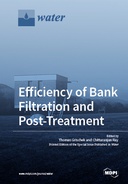Explore

Efficiency of Bank Filtration and Post-Treatment
Thomas Grischek and Chittaranjan Ray
2019
0 Ungluers have
Faved this Work
Login to Fave
Riverbank filtration (RBF) schemes for the production of drinking water are increasingly challenged by new constituents of concern, such as organic micropollutants and pathogens in the source water and hydrological flow variations due to weather extremes. RBF and new technology components are integrated and monitoring and operating regimes are adopted to further optimize water treatment in bank filtration schemes for these new requirements. This Special Issue presents results from the EU project AquaNES “Demonstrating synergies in combined natural and engineered processes for water treatment systems” (www.aquanes.eu). Additionally, papers from other research groups cover the efficiency of bank filtration and post-treatment, advantages and limitations of combining natural and engineered processes, parameter-specific assessment of removal rates during bank filtration, and the design and operation of RBF wells. The feasibility, design, and operation of RBF schemes under specific site conditions are highlighted for sites in the US, India, and South Korea
This book is included in DOAB.
Why read this book? Have your say.
You must be logged in to comment.
Rights Information
Are you the author or publisher of this work? If so, you can claim it as yours by registering as an Unglue.it rights holder.Downloads
This work has been downloaded 355 times via unglue.it ebook links.
- 355 - pdf (CC BY-NC-ND) at Unglue.it.
Keywords
- analytical method
- anoxic
- attenuation
- bank filtrate
- bank filtrate portion
- bank filtration
- Biofilm
- Climate Change
- clogging
- collector wells
- column experiments
- Damodar
- decentralized capillary nanofiltration
- Disinfection
- disinfection by-products
- dissolved organic carbon (DOC)
- dissolved organic matter
- drinking water hydropower
- drinking water treatment
- Droughts
- electro-chlorination
- Energy Efficiency
- energy generation
- entrance velocity
- environmental monitoring
- filter cake
- Floods
- fluorescence excitation-emission matrix
- gabapentin
- Gaṅgā
- Groundwater
- Heavy metals
- high temperature
- hydrochemistry
- hydrological trends
- inline electrolysis
- inorganic chemicals
- Iron
- Krishna River
- LC-OCD
- Manganese
- Microorganisms
- micropollutants
- mirror-image method
- Nakdong River
- nitrate
- optimization
- organic carbon
- organic matter composition
- organic matter degradation
- organic micropollutants
- out/in membrane comparison
- oxypurinol
- PARAFAC-EEM
- pathogen barrier
- Performance
- Pesticides
- pharmaceutical residues
- pharmaceuticals
- PHREEQC
- point-bar alluvial setting
- pressure loss
- redox sensitivity
- removal efficacy
- renewable energy
- river bank filtration
- riverbank filtration
- riverbank filtration (RBF)
- riverbed
- riverside water source
- rural water supply, online monitoring
- Salinity
- site investigation
- slow sand filtration
- small communities
- smart villages
- southern India
- storage tank
- sub-oxic conditions
- suboxic
- subsurface geology
- sulphate
- surface water treatment
- sustainable water production
- system costs
- trihalomethanes
- turbine
- Ultrafiltration
- Water quality
- Water Supply
- water treatment
- well structure remodeling
- Yamuna
Links
DOI: 10.3390/books978-3-03921-306-1Editions


